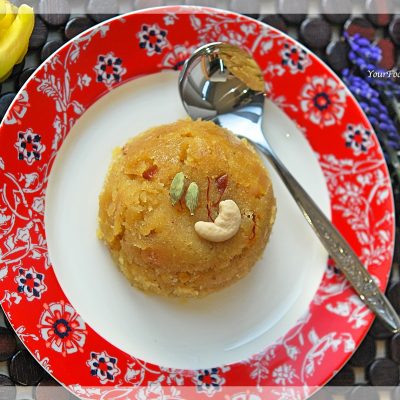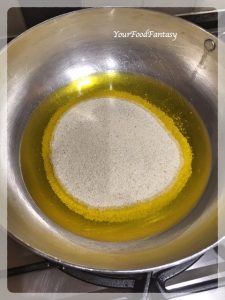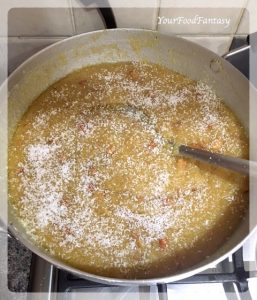Call it “Sooji ka Halwa“, “Sheera”, “Semolina Pudding”, “Navratri Prasad Halwa”, “Ashtami prasad”, “Jaagran Prasad”, it is one and same thing. Grew up seeing my mom making sooji halwa at home every time as Navratri prasad, or as a yummy dessert. When I tried to make same Sooji ka Halwa, in my first attempt, I ended up making a disaster. After a couple of attempts I got the trick on how make perfect sooji halwa, perfectly roasted semolina / sooji, just the right amount of water, sugar and other ingredients, incorporating my learnings in this sooji halwa recipe here.
Jump To
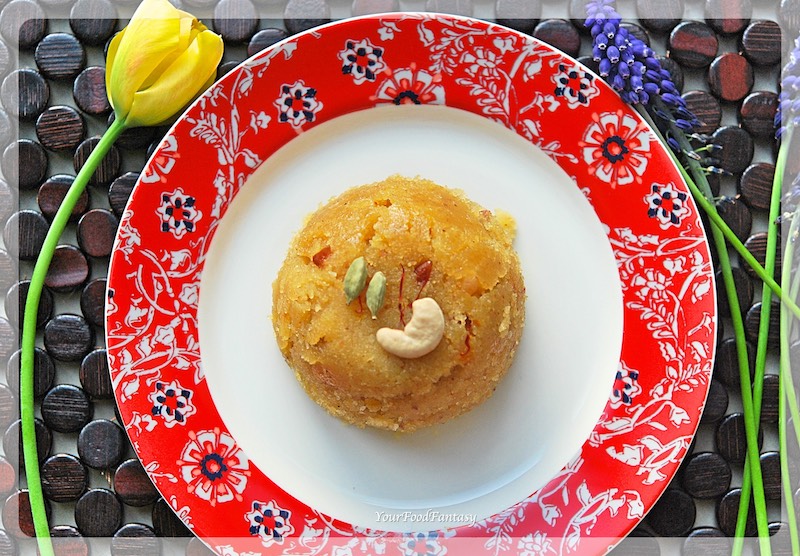
What is Sooji Halwa
Sooji Halwa or “Sooji Ka Halwa” is pudding made from semolina, ghee (clarified butter), sugar and water as the basic ingredients. You can top up other things like cashews, raisins, coconut, saffron to give sooji halwa even better taste (as well as fragrance).
You will notice that I have added milk in my recipe, though milk is optional, however addition of milk gives sooji halwa creamy texture, and helps in adding of saffron in halwa.
In the days when my mum used to make this halwa, it was very primitive with no nuts or saffron or even milk, yet it was delicious. So don’t feel disheartened in case you do not have nuts, however adding nuts will enhance the flavour.
How to make best Sooji Halwa
Key to a good sooji halwa is, having the ratio of sooji and ghee right. For every cup of sooji, I use 2/3cup of ghee.
Adding gram flour to the halwa
I have added gram flour in my recipe, reason for this is that gram flour enhances the taste of sooji halwa.
Roasting of sooji
It is extremely important to roast sooji till you can smell its roasted fragrance. This is one common disaster I have seen people do where they rush in and do not roast sooji. Roasting of sooji needs to be done on extremely low heat.
Adding liquid to halwa
When adding liquid, ensure constant stirring, else halwa will form lumps and won’t give consistent creamy texture. Be careful while adding liquid, as the pan will be hot and bubbles will form and can squirt out of pan. Keep the flame low and keep stirring.
Sweetness level
You can add more sugar as per your need.
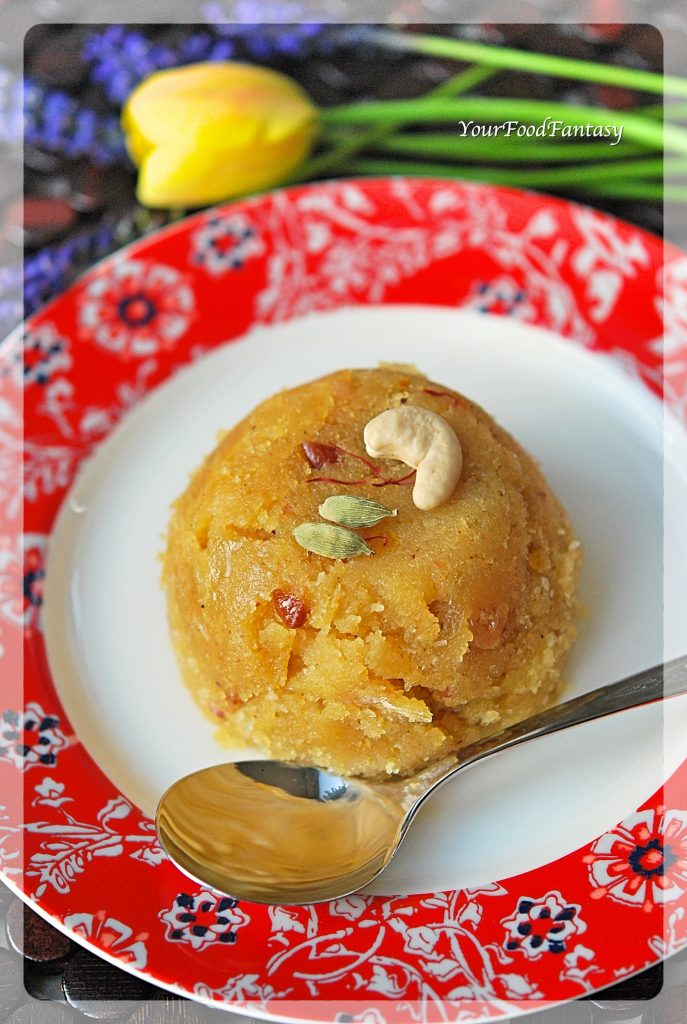
Method for making best semolina pudding
- Add sugar to the water in a pan and put it for boiling, stirring occasionally. Once it gets first boil, switch off the flame.
- Heat ghee / butter in a pan over low-medium heat and roast the semolina for 7-8 minutes stirring continuously.
- Add gram flour and wheat flour now and roast again for 5 minutes. Add cashews.
- Keeping the flame to the lowest, slowly add sugar syrup to roasted semolina stirring continuously so that no lumps forms. Add all the syrup and mix it well. Add saffron soaked milk and stir.
- After 5 minutes, add raisins and mix.
- Once halwa reaches your desired consistency, add cardamom powder and desiccated coconut. Mix them properly and switch off the flame
This halwa is same halwa which is made during Navratri as prasad on “Ashtami” or “Navmi”. Navratri can never be complete without this Halwa.
Serving Suggestion
Serve this halwa hot on its own. During Navratri, it is served with Poori and Black chick peas.
Other Halwa Recipes
You may also like to try other halwa recipes like
Almond Halwa
Moong Dal Halwa
Gajar / Carrot Halwa
Sooji Ka Halwa | Semolina Pudding
Ingredients
- 1 Cup Semolina (Sooji)
- 1.5 Tablespoon Whole Wheat Flour
- 1.5 Tablespoon Gram flour / Besan
- 1 Cup Sugar
- 3 Tablespoon Sugar Yes, Sugar is two times
- 2/3 Cup Ghee / Clarified Butter
- 3.5 Cups Water
- 1/4 Cup Cashews
- 1/4 Cup Raisins
- 2 Tablespoon Desiccated coconut
- 1 Teaspoon Cardamom Powder
- Few Strands Saffron
- 4 Tablespoon Milk Luke Warm
Instructions
- Chop cashews and soak the saffron strands in lukewarm milk. Add sugar to the water in a pan and put it for boiling, stirring occasionally. Once it gets first boil, switch off the flame.
- Heat ghee / butter in a pan over low-medium heat and roast the semolina for 7-8 minutes stirring continuously.
- Add gram flour and wheat flour now and roast again for 5 minutes. Add cashews.
- Keeping the flame to the lowest, slowly add sugar syrup to roasted semolina stirring continuously so that no lumps forms. Add all the syrup and mix it well. Add saffron soaked milk and stir. Increase the flame to medium now and stir it continuously as it will start thickening.
- After 5 minutes, add raisins and mix them.
- Once it reaches your desired consistency, add Cardamom powder and desiccated coconut. Mix them properly and switch off the flame.
- Serve hot and enjoy your “Sooji Halwa”.
Video
Notes
- Adding desiccated coconut is optional. You can skip adding it. Similarly you can add dry-fruits of your choice like Almonds, Chironji, and Pistachios.
- Always keep on stirring the halwa while adding sugar water, and keep on lowest flame as it bubbles up, be careful else you can end up getting hot drops on your hands.
- Keep in mind the consistency you want for your halwa, as it always thickens when gets little cold.
- You can always adjust the amount of sugar depending upon your taste. Here, in U.K. we get granulated sugar which is very fine, so have given the measurement based on that in the recipe above.
